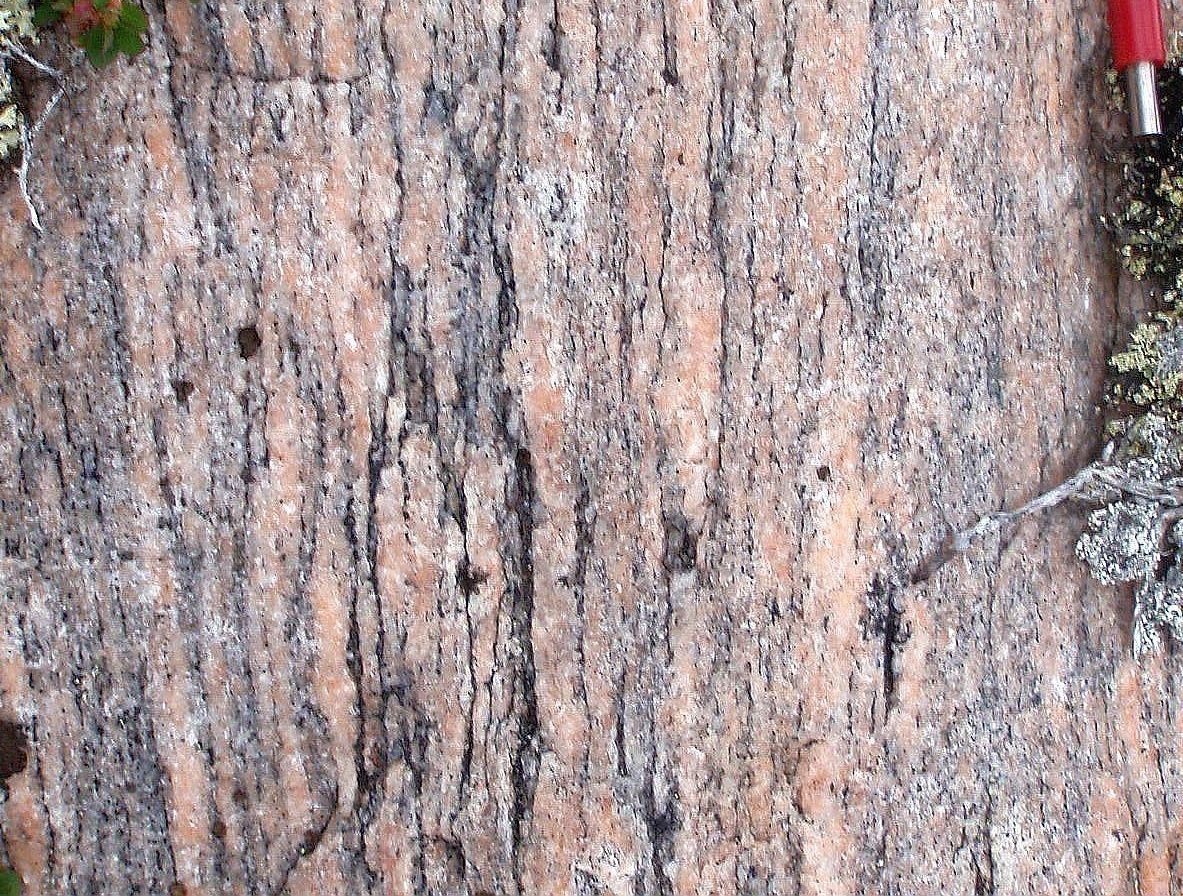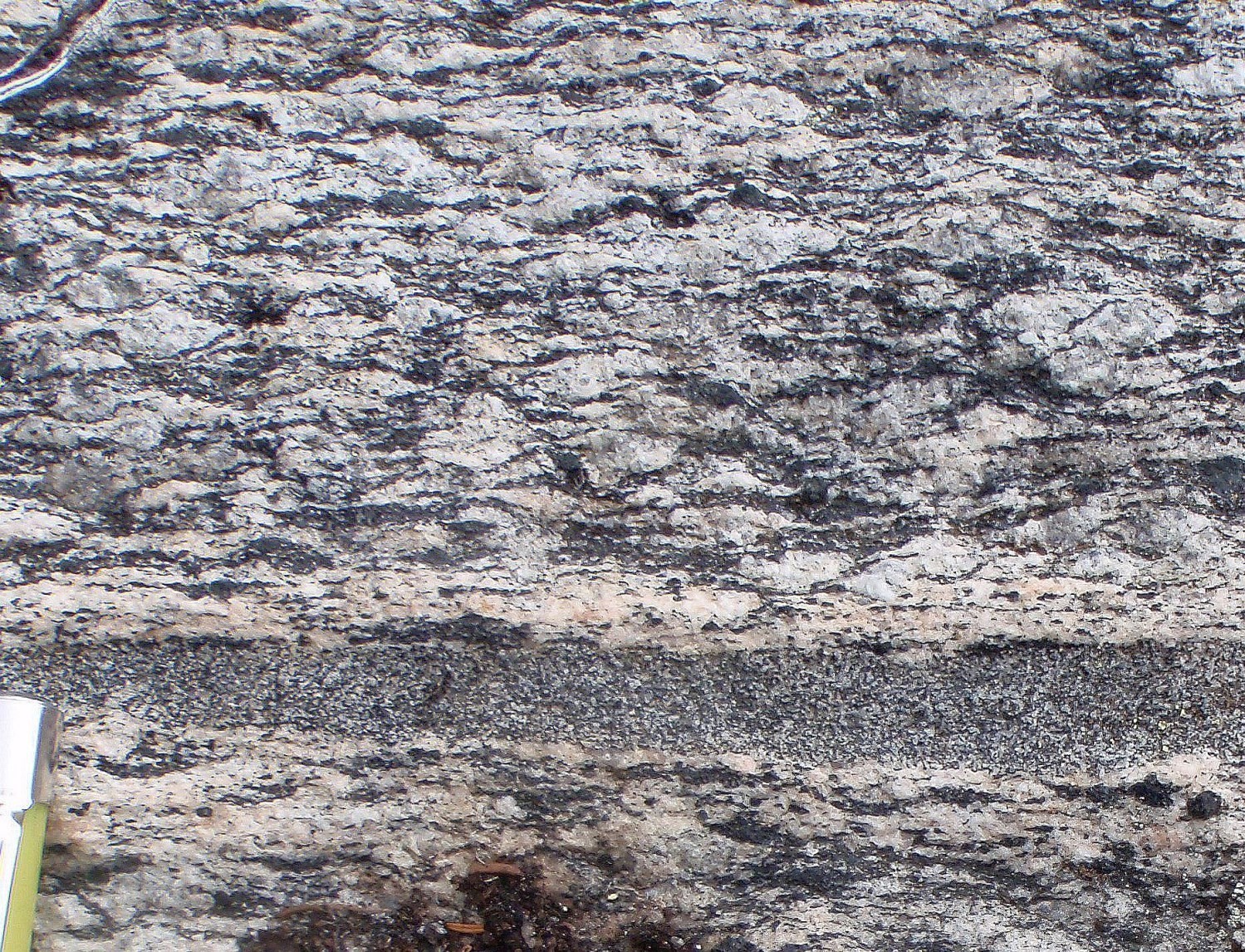| Author(s) | Simard et al., 2013 |
| Methodology | Defined from geological surveys and geophysical data |
| Geological(s) subdivision(s) | Churchill Province / Baleine Lithotectonic Domain |
| Main movement | Reverse, possibly dextral |
| Deformation style | Thrusting followed by late dextral movement |
| Metamorphic facies (mean facies related to main deformation) | Amphibolites to granulites |
Background and Methodology
The Gabriel Fault (FAgab) has been interpreted by Simard et al. (2013) in the Kuujjuaq area as a thrust fault that marks the boundary between their Gabriel and Baie aux Feuilles domains, to the west and east, respectively. These divisions were not retained by Lafrance et al. (2020) in their synthesis of the Southeastern Churchill Province (SECP). These authors therefore integrated the FAgab into the Baleine Lithotectonic Domain.
The information available on the FAgab is limited as it is rarely exposed on the surface and the work was carried out at scale 1:250 000.
Boundaries and Morphology
| Width | Undetermined |
| Length | 295 km |
| Orientation | NNW-SSE |
The Gabriel Fault crosses the northern third of the Baleine Lithotectonic Domain, where it generally separates volcano-sedimentary units of the Akiasirviup and Curot Suites in the west from the Kaslac Complex in the east. Its 295 km long trace is folded and follows the contact between units.
Stratigraphic Units Concerned
The lithodemic units affected by the FAgab are the False, Ralleau, Akiasirviup, Curot and Tasialuk suites as well as the Kaslac and Ungava complexes.
Structural Characteristics
❯ Main Fabrics
The FAgab’s main fabric is a secondary tectonometamorphic mineral foliation plane Sn. This fabric is commonly folded due to subsequent deformation. Its orientation is undulating but overall NNW-SSE. As with other thrust faults (Lac Hérodier, Lac Olmstead, Pingiajjulik, Pointe Reef, Rachel and Lac Turcotte) in the western part of the SECP, the FAgab would be associated with an early thrust phase and then folded during a subsequent deformation phase (Clark and Wares, 2004).
 Although the fault zone does not outcrop much, decimetric to metric layers of protomylonite and mylonite have been locally observed along the FAgab. These more deformed layers display a protomylonite or mylonite planar fabric. No lineation was measured along the fault. The more deformed zones are characterized by the presence of feldspar porphyroclasts, discontinuous quartz bands and subtle C/S fabrics.
Although the fault zone does not outcrop much, decimetric to metric layers of protomylonite and mylonite have been locally observed along the FAgab. These more deformed layers display a protomylonite or mylonite planar fabric. No lineation was measured along the fault. The more deformed zones are characterized by the presence of feldspar porphyroclasts, discontinuous quartz bands and subtle C/S fabrics.
❯ Other Fabrics
Not observed.
❯ Folds
Clark and Wares (2004) attribute the development of large open NW-SE folds having shallow plunges to the SE to a late dextral strike-slip movement along large thrust faults associated with the New Quebec Orogen. Simard et al. (2013) report that areas on either side of the FAgab are likely to be affected by folds overturned to recumbent towards the SW.
❯ Crosscutting Relationships
The FAgab meets a set of E-W deformation zones in the northern part of the Saffray Lake area (Lafrance et al., 2014). These deformation zones correspond to a major regional magnetic discontinuity that coincides with significant lithological and structural changes within the Baleine Domain (Lafrance et al., 2014, 2020). To the north of this E-W discontinuity, Archean gneiss of the Ungava Complex constitute the dominant lithology. These display a subhorizontal or shallowly dipping NW-SE to NNE-SSW foliation (Simard et al., 2013). To the south, the large younger Archean plutonic masses of the Saffray Suite and the cover of migmatized metasedimentary rocks are predominant and display an abrupt E-W foliation (Lafrance et al., 2014). According to these authors, it is possible that this regional E-W discontinuity is Archean and continues into the Superior Craton to the west, where it marks the boundary between the Douglas Harbour and Utsalik domains to the north and south, respectively.
❯ Kinematics
Several deformed outcrops were observed in the vicinity of the FAgab, but the movement along it could not be determined with certainty. However, kinematic indicators, mainly feldspar porphyroclasts, suggest dextral movement.
Deformation Style
The FAgab is interpreted by Simard et al. (2013) as belonging to the SW-verging thrust fault system of the NW part of the SECP. This main movement would have been followed by late dextral strike-slip.
Metamorphic Characteristics
The FAgab generally coincides with the metamorphic isograde associated with the disappearance of muscovite between the Akiasirviup and False suites (Charette et al., 2016). Parageneses observed in the False Suite are quartz-plagioclase-biotite ± garnet ± sillimanite ± hornblende (Lafrance et al., 2020). In the north of the Kuujjuaq area (Simard et al., 2013), the False Suite does not outcrop much and metasedimentary rocks of the Akiasirviup Suite, metamorphosed to the amphibolite facies, are in direct contact with granulite facies metamorphic rocks of the Kaslac Complex.
Alterations
Not observed.
Geophysical Characteristics
The FAgab corresponds to a relatively well-defined lineament on the regional aeromagnetic map.
Chronological Markers
The major collision event in the western part of the SECP corresponds to the edification of the New Quebec Orogen, which occurred between 1.82 Ga and 1.77 Ga (Wardle et al., 2002). Transpressive stresses developed during this oblique collision resulted in the formation of thrust and strike-slip faults (Clark and Wares, 2004). Faults in the western part of the SECP, including the Gabriel Fault, would have acted as thrust faults at the beginning of the orogenic phase, and would have been transformed into dextral strike-slip faults towards the end of the orogenic phase (Clark and Wares, 2004). Recent dating indicates burial of metasedimentary rocks in the Rachel-Laporte Lithotectonic Domain – located west of the Baleine Domain – under conditions of average crustal thickness at ~1804 Ma (Godet et al., 2020). This episode of thrusting and crustal thickening appears to predate the final dextral strike-slip movement, which would have occurred between 1793 Ma and 1783 Ma (Machado et al., 1989; Clark and Wares, 2008).
References
Publications Available Through Sigéom Examine
CLARK, T., WARES, R., 2004. Synthèse lithotectonique et métallogénique de l’Orogène du Nouveau-Québec (Fosse du Labrador). MRNFP; MM 2004-01, 182 pages, 1 plan.
DAVIS, D.W., SUTCLIFFE, C.N., 2018. U-Pb Geochronology of Zircon and Monazite by LA-ICPMS in Samples from Northern Quebec. University of Toronto, MERN; MB 2019-01, 113 pages.
DAVIS, D.W., MOUKHSIL, A., LAFRANCE, I., HAMMOUCHE, H., GOUTIER, J., PILOTE, P., TALLA TAKAM, F., 2015. Datations U-Pb dans les provinces du Supérieur, de Churchill et de Grenville effectuées au JSGL en 2012-2013. MERN; RP 2014-07, 56 pages.
DAVIS, D.W., SIMARD, M., HAMMOUCHE, H., BANDYAYERA, D., GOUTIER, J., PILOTE, P., LECLERC, F., DION, C., 2014. Datations U-Pb effectuées dans les provinces du Supérieur et de Churchill en 2011-2012. University of Toronto, MERN; RP 2014-05, 62 pages.
LAFRANCE, I., VANIER, M.-A., CHARETTE, B., 2020. Domaine lithotectonique de Baleine, sud-est de la Province de Churchill, Nunavik, Québec, Canada : synthèse de la géologie. MERN; BG 2020-07, 2 plans.
LAFRANCE, I., SIMARD, M., BANDYAYERA, D., 2014. Géologie de la région du lac Saffray (SNRC 24F, 24G). MRN; RG 2014-02, 51 pages, 1 plan.
SIMARD, M., LAFRANCE, I., HAMMOUCHE, H., LEGOUIX, C., 2013. Géologie de la région de Kuujjuaq et de la baie d’Ungava (SNRC 24J, 24K). MRN; RG 2013-04, 62 pages, 1 plan.
Other Publications
CORRIGAN, D., WODICKA, N., McFARLANE, C., LAFRANCE, I., VAN ROOYEN, D., BANDYAYERA, D., BILODEAU, C., 2018. Lithotectonic framework of the Core Zone, Southeastern Churchill Province. Geoscience Canada; volume 45, pages 1-24. doi.org/10.12789/geocanj.2018.45.128
GODET, A., GUILMETTE, C., LABROUSSE, L., DAVIS, D.W., VANIER, M.A., LAFRANCE, I., CHARETTE, B., 2020. Contrasting P-T-t paths reveal a metamorphic discontinuity in the New Quebec Orogen: insights into Paleoproterozoic orogenic processes. Precambrian Research; article 105675. doi.org/10.1016/j.precamres.2020.105675
PERREAULT, S., HYNES, A., 1990 Tectonic evolution of the Kuujjuaq terrane, New Québec Orogen. Geosciences Canada; volume 17, pages 238-240. journals.lib.unb.ca/index.php/GC/article/view/3695
POIRIER, G.G., 1989. Structure and metamorphism of the eastern boundary of the Labrador Trough near Kuujjuaq, Québec, and its tectonic implications. McGill University; master thesis, 174 pages.
POIRIER, G., PERREAULT, S., HYNES, A., LEWRY, J.F., STAUFFER, M.R., 1990. Nature of the eastern boundary of the Labrador Trough near Kuujjuaq, Quebec. In The Early Proterozoic Trans-Hudson Orogen of North America: Lithotectonic Correlations and Evolution (Lewry, J.F. and Stauffer, M.R., editors). Geological Association of Canada; Special Paper 37, pages 397-412.
RAYNER, N.M., LAFRANCE, I., CORRIGAN, D., CHARETTE, B., 2017. New U-Pb zircon ages of plutonic rocks from the Jeannin Lake area, Quebec: an evaluation of the Kuujjuaq Domain and Rachel-Laporte Zone. Geological Survey of Canada; Current Research 2017-4, 14 pages. doi.org/10.4095/306180
WARDLE, R.J., JAMES, D.T., SCOTT, D.J., HALL, J., 2002. The southeastern Churchill Province: synthesis of a Paleoproterozoic transpressional orogen. Canadian Journal of Earth Science; volume 39, pages 639-663. doi.org/10.1139/e02-004
Suggested Citation
Ministère de l’Énergie et des Ressources naturelles (MERN). Gabriel Fault. Quebec Structural Lexicon. https://gq.mines.gouv.qc.ca/lexique-structural/faille-de-gabriel_en/ [accessed on day month year].
Contributors
|
First publication |
Isabelle Lafrance, P. Geo., M.Sc. isabelle.lafrance@mern.gouv.qc.ca; Marc-Antoine Vanier, Jr. Eng., M.Sc. marc-antoine.vanier@mern.gouv.qc.ca, (redaction); Ghyslain Roy, P. Geo. (coordination); Claude Dion, Eng., M.Sc. (critical review); Simon Auclair, P. Geo., M.Sc. (editing); André Tremblay (HTML editing); Céline Dupuis, P. Geo., Ph.D. (english version) |



